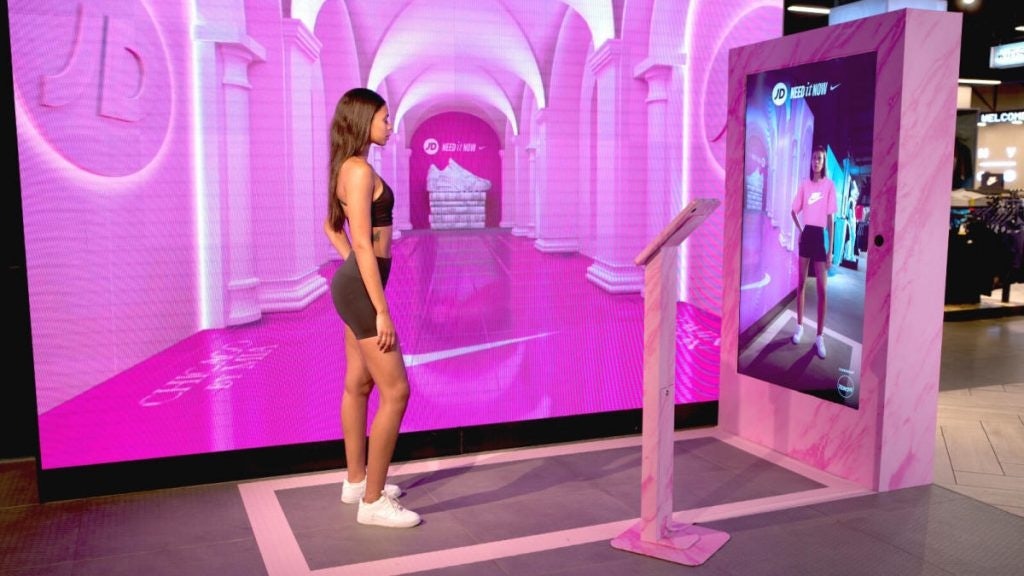Last year, luxury wanted a slice of the non-fungible token (NFT) and metaverse pies, with umpteen fashion brands hastily diving into the digital space. Fast-forward to 2023 and Web3 has undergone a seismic shift as a result of this gold rush going bust. Crashes, controversies, rug-pulls all seemed to happen at once, forcing the luxury and fashion world to refine their Web3 strategies in a maturing and more cautious market.
Jing Daily takes a look at the emerging trends and novel concepts surfacing across the digital sphere today, and what they mean for the future of fashion.
While 2022 was marked by a crypto market crash, waning popular interest, a lack of Web3 tech nous, and saw numerous digital gimmicks flounder, there are still considerable opportunities for the fashion industry in Web3.

Immersive e-commerce#
One of the biggest Web3 trends this year has been the expansion of experiential immersive e-commerce. Also referred to as i-commerce, the digitalization of stores and retail experiences has boomed over the past nine months, catching the attention of businesses including Lancôme, Lululemon, Ralph Lauren, and Charlotte Tilbury.
Erika Lang, Head of Americas at Journee, the virtual e-commerce company behind Clinique and H&M’s activations, tells Jing Daily, “without a doubt, i-commerce is the most applicable and accessible adoption of Web3 right now. It’s the natural evolution of shopping online. Gone are the days of clicking through sterile 2D online stores with flat images. There's so much more that brands can achieve by using i-commerce to drive deeper customer engagement and business impact.”
It’s now estimated that the immersive category’s market value could reach nearly $800 billion next year according to Bloomberg Intelligence, and Acxiom’s Beyond the Metaverse: CX Predictions for 2023 survey found that immersive shopping is one of the major e-commerce trends shaping retail.
Beyond its novelness, it’s also a prime avenue for data tracking, providing brands with a highly detailed overview on customer spending habits, product best-sellers, (virtual) foot traffic, and browsing time.

AR-powered store experiences#
While virtual stores are taking consumers deeper into the world of digital content, augmented reality (AR) is enhancing the physical world around them.
According to Zion Market Research, smart mirror market revenue was around $3.44 billion in 2022 and is projected to reach $7.3 billion by 2028.
This year has seen more and more brick-and-mortar retailers eye a piece of the action. Physical storefronts, such as JD Sports, Tiffany & Co, Tommy Hilfiger, and Coach are now deploying AR tech – particularly in the form of try-on mirrors – in their physical shopping spaces.
AR enablers and innovators like Zero10 are making this happen. The Cyprus-based company is on every fashion house’s radar this year, thanks to its proprietary AR mirror that is redefining the customer try-on experience.
“Some brands are aiming for unique experiences to draw in more customers, while others want to boost in-store time and ultimately increase purchases,” George Yashin, founder of Zero10 tells Jing Daily. “Objectives vary, but companies are starting to see the real value in the role of AR solutions for their businesses. The brands that have already embraced this innovation will be the frontrunners in this fast-evolving landscape."

AI-generated content#
AI-generated content and machine learning technologies are now an ubiquitous tool for companies and brands, as outlined in Jing Daily’s “The Future of Generative AI for Luxury Brands” report, despite only breaking onto the mainstream last year.
“AI could give a luxury brand the opportunity of engaging a wider community of potential consumers by creating new fields of action, halfway between dream and reality,” AI footwear designer Marco Simonetti told Jing Daily at the start of this year.
This sentiment is just as relevant today, with more fashion labels and independent designers exploring the possibilities of AI in their own strategies.
The tech has exploded onto the scene across China, too, where companies seemingly have a better grasp of how to tap the trend to resonate with consumers. The mainland’s AI market value is expected to exceed $26 billion by 2026, thanks to widespread investment and adoption.
That said, challenges remain, including gray areas concerning how AI content is regulated and copyright protection is enforced. An especially contentious segment is AI-generated humans. As legislation solidifies, luxury fashion labels’ use of AI is set to rise significantly.

Exclusive phygital products#
While McKinsey estimates that the digital fashion market will top $2 trillion in the next seven years, most luxury fashion investors are yet to see real value in digital assets. To counter this attitude, brands are connecting virtual twins to physical counterparts to provide buyers with double the value, and creating a new range of ‘it’ products in the process.
Gucci remains at the forefront of this trend, with other luxury fashion contenders yet to catch on. In April thai year, Gucci’s teamed up with Web3 community Yuga Labs, generating huge social buzz thanks to its phygital offering, which saw the collaboration launch its debut ‘relic’ in the form of a KodaPendant. The maison also launched an exclusive physical collection of branded handbags and wallets for its Web3 community earlier this year.
Likewise, Ralph Lauren x Fortnite’s phygital P-Wing boot sold out almost instantly thanks to its gaming-inspired element.
Having the physical component is key to onboarding luxury consumers who are not yet ready to go fully virtual. It’s a palatable and accessible stepping stone into the digital world.

NFT-powered community memberships#
While NFTs have decreased in popularity this year due to last year’s market crash, multiple rug-pull scandals, and prevailing skepticism, brands are scoping out new opportunities to harness virtual assets in a way that provides value to consumers, minus the risk.
With companies desperate to cultivate strong relationships with customers in order to gain their loyalty, NFT-powered community memberships have become a popular gateway to onboarding audiences through exclusive incentivization – perks that often deliver access to special events, first dibs on new collections, and a direct line to favorite brands.
Luxury has taken note. Mercedes-Benz, Asprey Studio, Adidas, and Gucci are just a few of many big players that now offer their own dedicated token-gated memberships to audiences. This approach is resonating with brand loyalists well.
Last month, Mercedes Benz’s new Web3 venture, dubbed NXT, closed down its digital pass launch due to an influx of users crashing servers. Though many expressed frustration over the auto manufacturer’s lack of preparation, the incident brought to light just how in-demand exclusive token-gate arenas are.

